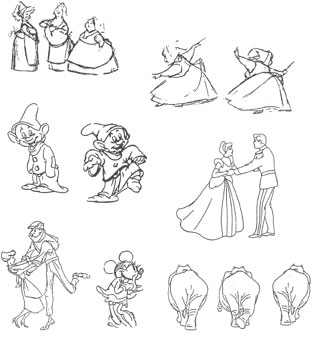33 Drapery — Its Role in Drawing
Drawing from a model with clothing or costume can be a real challenge. Wrinkles, folds, seams, belts, pleats, ruffles, and shirring all seem so important and at times, downright overwhelming. Their importance cannot be denied, but their reason for being there and looking the way they do must be carefully considered lest we find ourselves drawing lines, lumps, pieces of cloth, and incidental paraphernalia rather than a human presenting us with a gesture to draw, who is incidentally wearing some clothes or a costume.
For our purposes, the clothed figure suits our needs — forces us to the brink of our drawing capabilities. Our job as animators (layout, story, etc.) is to be surrogate actors for our cartoon characters who will be wearing countless kinds of costumes. Let’s face it, clothes cannot act. If clothes seem to act it is because the body underneath is acting (posing or gesturing). The clothes will react in a like manner and will even enhance the gesture. But if the drawing has not captured the gesture, all the manipulation of wrinkles, lumps, bulges, folds, seams, and superficial incidentals one can dream up will not bring off the drawing. A real solid, expressive, sparkly drawing is one where the clothing is doing what the body is causing it to do.
Reasons! Reasons! Reasons! Always look for logical reasons for the shapes of the clothing or drapery — and the reason will always be found in the bodily gestures.
It helps to mentally take the clothing apart to see how it is constructed; for instance, a sleeve — how big around is the shoulder opening, how is it attached to the bodice, does it taper, does the shoulder seam attach at or below the shoulder? Ward Kimball’s great observation is very apropos here. He said if he could take something apart and put it back together again, he could draw it.
For the sake of studying the figure for animation, lines of clothing should not be sketched in just for an impression — they should be logical. If you were to use that drawing in a scene, those drapery lines would have to animate as a secondary action with the primary action being the body itself.
Here are some beautiful examples of how the clothing can be handled in a simple way, yet be effective in complimenting the action.

